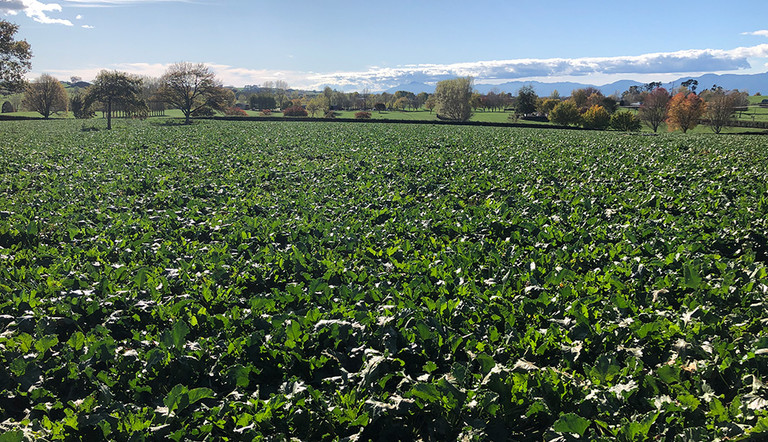
Trials reveal new Gold standard in beet weed control

Innovative Goltix Gold, from crop protection company ADAMA NZ, has a reduced hazard profile compared to industry standard Goltix Flo without compromising the proven efficacy.
In fact, far from it. Trials have shown Goltix Gold is actually even more effective on some hard-to-kill weeds. Fodder beet trials in Canterbury and red beet (beetroot) trials in Hawke’s Bay showed Goltix Gold was as efficacious as Goltix Flo for overall control of beet weeds and more effective on the hard to control weeds fathen and wireweed.
Crop-safe at pre-emergence and cotyledon stage, Goltix Gold is compatible with commonly used herbicides and insecticides, with no phytotoxicity or vigour reduction observed in any commonly used tank-mixture.
Safer handling and improved efficacy
There are also advantages in the simplified handling requirements. The change in formulation of Goltix Flo to Goltix Gold means that it is not required to be under the control of a Certified Handler, nor is tracking needed. What is more, Goltix Gold represents reduced risk to aquatic environments than other formulations and suitably qualified people are not required for mixing and loading.
The locations chosen for the Goltix Gold trials were highly tactical. Canterbury along with Southland is where the bulk of fodder beet is grown, and Blair Hopkins, ADAMA NZ National Sales Manager, says the weeds encountered in trials were typical of the region. “There was a pretty good mix of weeds, especially fathen and wireweed.”
Hawke’s Bay was selected as it is New Zealand’s largest beetroot producer.
The Goltix Gold registration has already been greeted with enthusiasm by distributors. Elisabeth Johnston, ADAMA NZ Marketing Manager, says the welcoming response to Goltix Gold is heartening, but not entirely surprising. “Distributors and growers are aware of the need to protect people working in agriculture, waterways and the environment. If they can do that with an even better performing product, all the better!”
At forefront with effective and safe solutions
ADAMA NZ has long been at the forefront of supplying solutions that are both effective and safe to sensitive growth stages in beet crops. For instance, Rifle® can be applied at cotyledon stage without damaging the delicate beet plants thanks to the specially developed SE formulation.
The registration of Goltix Gold is the logical next step in a programme, which has boosted beet yields and made a strong contribution to the management toolbox for the highly technical crop.
Once the canopy is established, beets will hold their own. Before that point, however, they are very competition averse. As Doug Speers, ADAMA NZ Commercial Manager, says: “It’s essential to keep on top of weeds until the crop is at canopy closure to maximise yields.”
Specially designed programme with robust pre-emergence spray
ADAMA NZ’s specially designed herbicide programme for beet is based on a robust pre-emergence spray, with follow-up that controls any subsequent weeds and provides the best possible start for the valuable, high yielding crops such as fodder, sugar and red beet, and mangolds.
The programme, including Goltix WG Herbicide, Goltix Uno Herbicide, Ethosat® Herbicide, Rifle, and now Goltix Gold, has been rigorously tested and refined to complement New Zealand growing conditions and beet varieties.
The proof of that success was perhaps nowhere better demonstrated than in the drought conditions experienced last season in the North Island, a challenge which will resonate with Canterbury growers.
Doug watched, back in May, as a Matamata sugar beet crop was harvested almost as fast as the trucks could transport it. “The truck was filled in about 15 minutes.”
Doug says the “green oases” the beet crops provided among the arid paddocks in the region reminded him of Canterbury some decades ago when lucerne would’ve been the stand-out crop.
“I was impressed. The beets have done well in the dry – definitely out-shining a lot of the maize crops. A lot of maize struggled in the dryer than average conditions.”
Technical, but high yielding crop
Doug says beet is recognised as a highly technical crop requiring careful management, but the yields are there for those prepared to plan and take advantage of robust programmes and sage advice. “There’s some good expertise around beet crops now.”
Farmers using the ADAMA programme were happy with it and got effective control. But Doug says nothing beats ‘boots on the ground’ for spotting new strikes of weeds.
“We’d recommend that crops be inspected weekly during the crop establishment phase, the initial five weeks or so. That said, you can’t beat beet for high energy, kilograms of dry matter per hectare and getting a bigger crop off fewer hectares.”